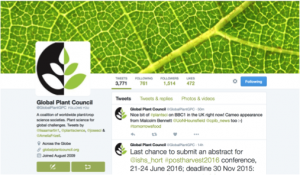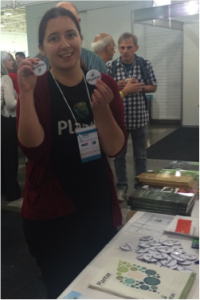Here at the GPC we love social media. It provides a fantastic platform upon which we can spread awareness about our organisation and the work we do. Since Lisa Martin’s appointment as Outreach and Communications Manager in February of this year, and the New Media Fellows two months later, we have expanded our online presence and are reaching more people than ever before. We still have a way to go, but here are a few things we’ve learnt over the past year that might provide you with a bit more social media know-how.
- Tweet, tweet, and tweet some more
To increase your following as an individual try to produce maybe one or two good tweets everyday. If you’re tweeting on behalf of an organization and have more time or people power, 5–8 tweets a day should be your target.

The Global Plant Council twitter account now has over 1500 followers. Find us @GlobalPlantGPC
Our Twitter following has grown rapidly over the past year. We had 294 followers on Twitter in September 2014 and now have over 1500! Much of this has been down to there now being four of us maintaining the account rather than Ruth Bastow (@PlantScience) on her own.
The more you tweet, and the better you tweet, the more followers you will get. Things move fast in the Twittersphere, so just a few days of inactivity can mean you drop off the radar.
For more hints about using Twitter see this great article from Mary Williams (@PlantTeaching): Conference Tweeting for Plant Scientists Part 1 and Part 2.
- If your followers won’t come to you, go to your followers
Decide on who you want to connect with, find out which social media platform they se most, and set yourself up!
As a global organization we want to connect with all our members and plant scientists around the world, so we need to use different means of communication to do this. In April 2015 we set up a Spanish language Twitter account with Juan Diego Santillana Ortiz (@yjdso), an Ecuadorian-born PhD student at Heinrich-Heine University in Dusseldorf, Germany, who translates our tweets into Spanish.
Of course Twitter is not universally popular, and our main following seems to come from the

The newest edition to the GPC social media family is our GPC Scoop.It account which you can find here
UK and US. To connect with those choosing to use different communication platforms, New Media Fellow Sarah Jose set up a GPC Scoop.It account in September 2015. Around this time we also set up a GPC Facebook page after many of our member organizations told us this was their primary means of connecting with their communities. Although relatively new, this page is slowly gaining momentum and we hope it will provide a great outlet for conversation in the future. Find out about which of our member organizations are on Facebook here.
If there’s a site you use to stay up to date with science content that we don’t have a presence on, do let us know and we will look into setting up an account!
- Generate your own content
Ultimately, the best way to expand your reach online is to generate your own content.
The GPC blog was started in October 2014, and in its first 14 months of life received an average of 142 views per month. However, since Lisa, myself and Sarah started working with the GPC, we have been generating one blog post every week, with the result of our monthly views shooting up to almost 700 views per month since May.
This just shows that generating interesting and regular content really does work in terms of increasing reach and online presence. All these blog posts have also contributed towards a growing following on our various social media sites over the past six months.
If you want to write for us, please send us an email or get in touch on Twitter! We are always looking for contributions from the plant science community. Perhaps you’ve recently attended a scientific meeting, are doing a really cool piece of research, organized a great outreach activity or have seen something relevant in the news. Whatever it is, we want to know.
We’re also happy to write about the GPC for your blog or website, so if you would like us to contribute an article, please get in touch!
- Cover as many platforms as possible
Try to have a global presence across as many platforms as you think you can maintain, although an inactive account on any social media site won’t do you any favors, so don’t take on too much!
I’ve already described our presence on Twitter, Facebook, Scoop.It and the blog, all of which help make our organization accessible, however people want to use social media.
In addition to this we of course have the GPC website, and Lisa sends out a monthly e-Bulletin providing a summary of all the information published on the website for that month. Anyone can sign up here to stay up to date with our activities, and it’s free!
In a bid to further reach out to members that perhaps don’t engage with social media (yet!), Lisa wrote this article explaining what the GPC does and sent it out to be published by our various member organizations.
- Plantae

New Media Fellow Sarah Jose promotes our new Plantae platform at IPMB 2015
Confession time, this isn’t really a helpful hint on how to use social media, but Plantae is so good it deserves a section all on its own!
We are hoping Plantae, set up by the GPC in collaboration with the ASPB, and with support from the SEB, will be the digital ecosystem for the plant science community. It will provide a platform for plant scientists to collaborate with one another, network, and access journals, advice and jobs. You can read more about Plantae on our blog, here.
It’s now in beta testing and you can sign up to give it a go at http://www.plantae.org. Let us know what you think!








